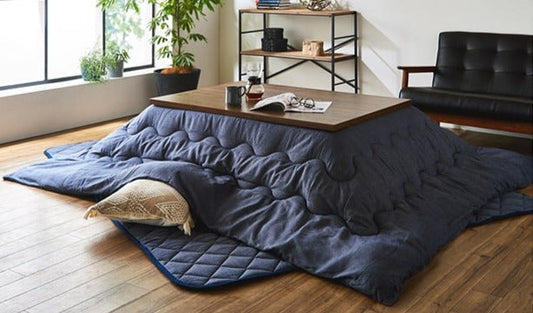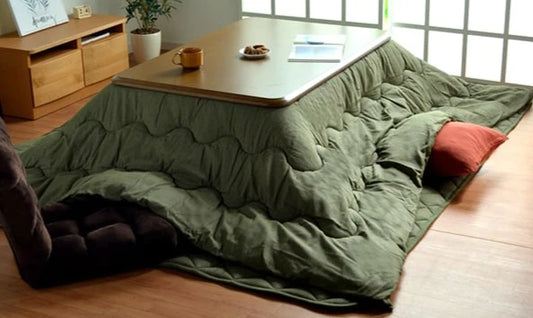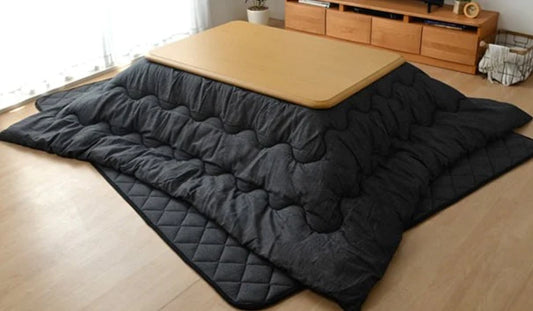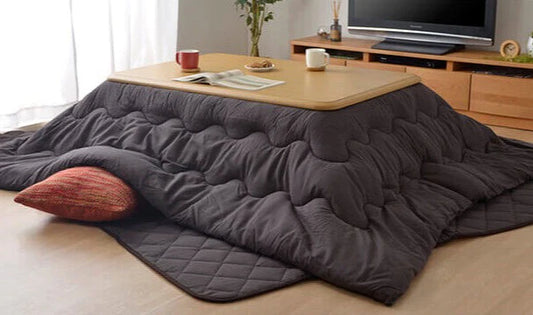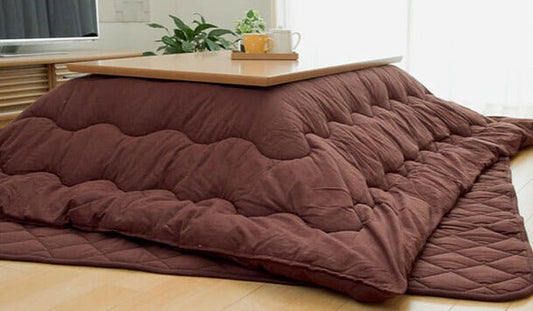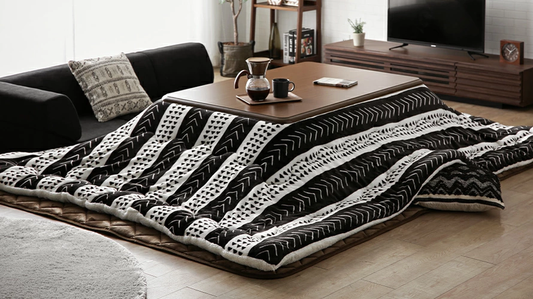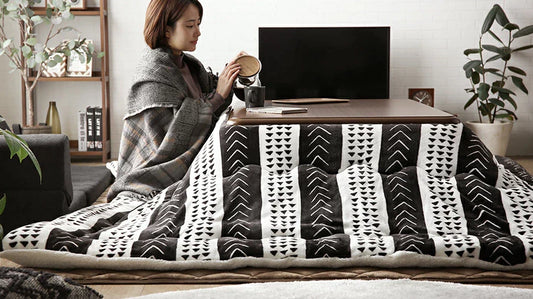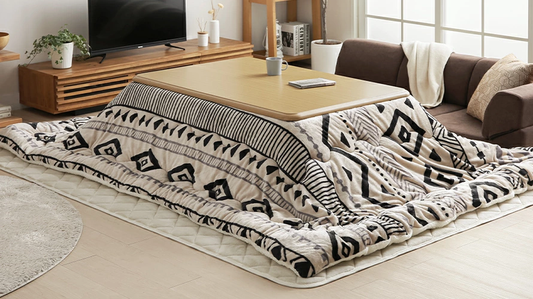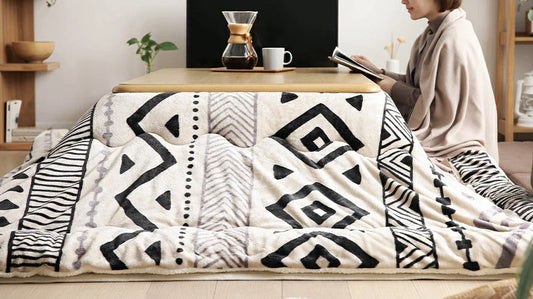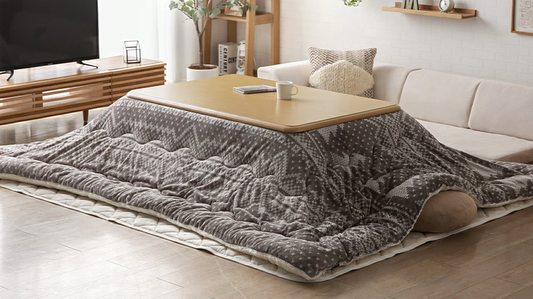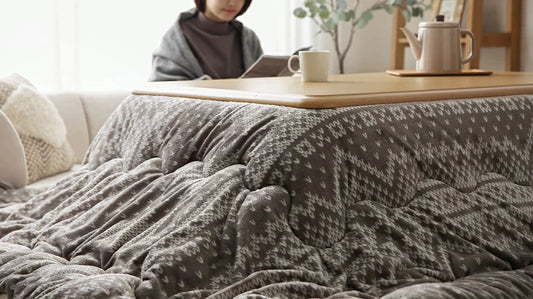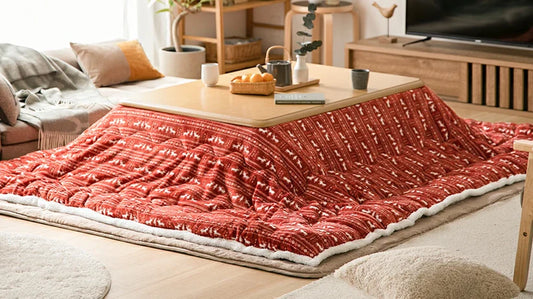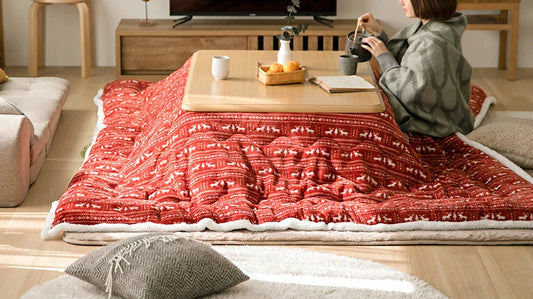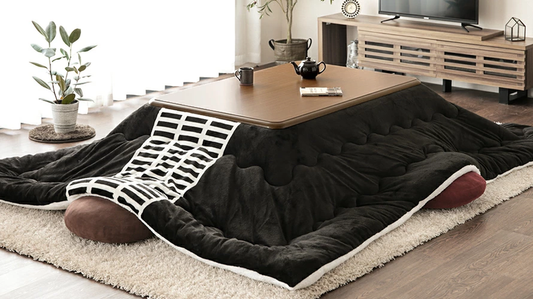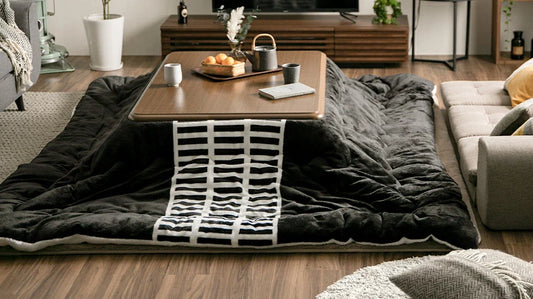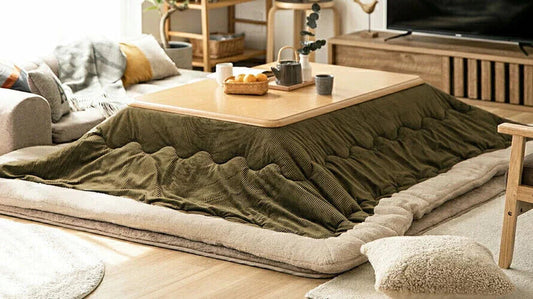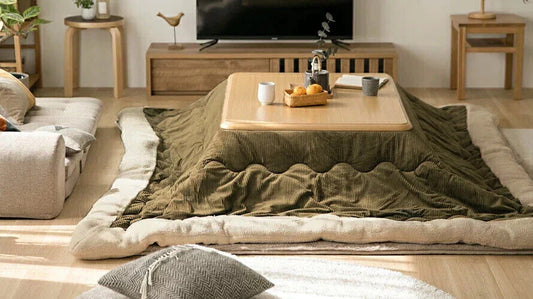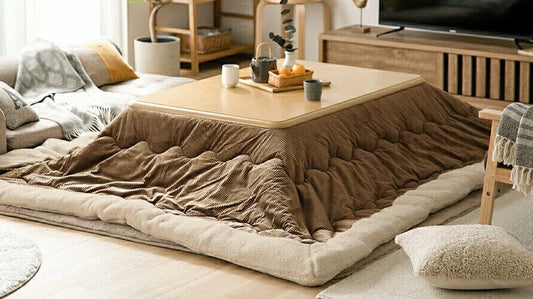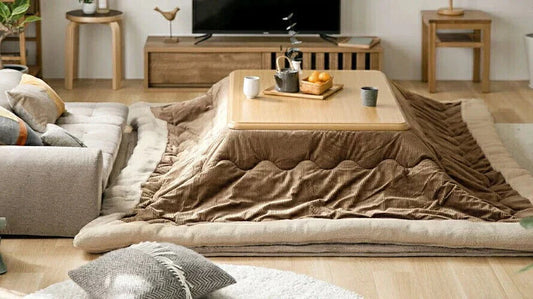Kotatsu
Authentic Kotatsu from Japan
-
Denim Navy Kotatsu Table
Regular price $699.00 USDRegular priceUnit price / per -
Denim Khaki Kotatsu Table
Regular price $699.00 USDRegular priceUnit price / per -
Denim Black Kotatsu Table
Regular price $699.00 USDRegular priceUnit price / per -
Tsumugi Black Kotatsu Table
Regular price $699.00 USDRegular priceUnit price / per -
Tsumugi Green Kotatsu Table
Regular price $699.00 USDRegular priceUnit price / per -
Tsumugi Burgundy Kotatsu Table
Regular price $699.00 USDRegular priceUnit price / per -
Native Black Kotatsu Table
Regular price $699.00 USDRegular priceUnit price / per -
Native White Kotatsu Table
Regular price $699.00 USDRegular priceUnit price / per -
Nordic Grey Kotatsu Table
Regular price $699.00 USDRegular priceUnit price / per -
Nordic Red Kotatsu Table
Regular price $699.00 USDRegular priceUnit price / per -
Grid Black Kotatsu Table
Regular price $699.00 USDRegular priceUnit price / per -
Corduroy Green Kotatsu Table
Regular price $759.00 USDRegular priceUnit price / per -
Corduroy Brown Kotatsu Table
Regular price $759.00 USDRegular priceUnit price / per
Exploring the Benefits of a Kotatsu
A kotatsu is a traditional Japanese heating device that has become increasingly popular around the world in recent years. For those unfamiliar, it's a low, wooden table frame covered by a heavy blanket or futon. Underneath the table is a heat source, traditionally charcoal but often replaced with a modern electric heater. This creates a cozy pocket of warmth that people can gather around, slipping their legs inside to stay toasty in the colder months.
While the kotatsu's primary function is providing warmth, it offers a host of benefits that extend far beyond simple temperature control. Let's delve into the world of the kotatsu and uncover why it holds a special place in Japanese homes and hearts.
The Allure of Coziness
The most obvious appeal of a kotatsu is the sense of irresistible coziness it creates. In the depths of winter, there's something incredibly comforting about snuggling under the thick blanket, feeling the warmth radiate through your body. It's a safe haven from the outside chill, a space designed for relaxation and comfort. The kotatsu beckons you to slow down, shed the stresses of the day, and simply be.
Social Connection and Communal Joy
The design of a kotatsu naturally fosters a sense of togetherness. It provides a shared space for families and friends to gather, chat, play games, or simply enjoy each other's company. In an age where technology often isolates us, the kotatsu offers a heartwarming counterpoint. It creates a physical and emotional space for connection, fostering conversations and deepening bonds.
Imagine heartwarming scenes of families sharing stories and laughter over steaming cups of tea, groups of friends engrossed in lively board games, or couples snuggled together in quiet companionship. The kotatsu acts as a facilitator of these precious moments of shared joy and connection.
Energy Efficiency and Cost Savings
While a luxurious indulgence, the kotatsu also boasts a surprisingly practical side. Traditional Japanese houses were often drafty, and central heating was less common. The kotatsu allowed for targeted, localized heating, providing warmth without the need to warm an entire room or house. Even in modern times, this localized approach to heating can lead to energy savings compared to heating an entire space. By cozying up in the kotatsu, you might find less need to crank up your central heating system.
A Touch of Nostalgia and Tradition
The kotatsu's origins date back to the Muromachi period (14th century) of Japan. Initially, a charcoal brazier would be positioned under a simple low table, and people would wear heavily padded robes to stay warm. Over time, it evolved into the recognizable kotatsu we see today. For the Japanese, the kotatsu holds a special place in their cultural memory. It evokes feelings of nostalgia, tradition, and heartwarming moments spent with loved ones.
Even for those outside of Japan, there's something charming about the simplicity and timelessness of the kotatsu. It represents a slower pace of life, a dedication to comfort, and an appreciation for the small connections that make life meaningful.
Improved Circulation and Well-Being
Believe it or not, sitting beneath a kotatsu brings potential health benefits. The gentle radiant heat can help improve circulation, especially in the lower extremities. This can be particularly beneficial for those who suffer from cold feet or conditions like Raynaud's disease. Moreover, the warmth of the kotatsu can promote relaxation, reduce muscle tension, and provide a sense of overall well-being.
Multifunctional Space Saver
The kotatsu's versatility makes it a clever addition to smaller homes. In many Japanese households, it serves as the centerpiece of the living area. During the day, it acts as a regular table for working, studying, or having meals. As the temperature drops, the addition of a blanket and heater transforms it into a snug heating haven. This dual functionality makes the kotatsu a wonderful solution for maximizing space, particularly in smaller apartments or homes.
Kotatsu Safety Tips
While kotatsus are a wonderful source of comfort and warmth, it's important to use them with a focus on safety. Here's a guide to ensuring a cozy and hazard-free experience:
Fire Safety
Choose Electric Heaters: Modern electric heaters are far safer than traditional charcoal braziers. They offer better temperature control and minimize the risk of fires or carbon monoxide poisoning.
Check Heater Condition: Inspect the heater's cord and plug regularly for fraying, damage, or loose connections. If you notice anything concerning, replace the heater immediately.
Unplug When Not in Use: Always unplug the heater before going to bed or leaving the house. It's a simple step that significantly reduces fire risks.
Ventilate: Even with electric heaters, ventilation is crucial. Regularly air out the room to prevent a build-up of carbon dioxide, especially in smaller spaces.
Flame-Retardant Fabrics: Opt for blankets and futons made from flame-retardant materials for added protection.
Burn Prevention
Mindful Placement: Place your kotatsu away from flammable materials like curtains, papers, or loose clothing.
Gradual Exposure: Don't rush into the kotatsu when you're cold. Allow your body to adjust gradually to the warmth to prevent accidental burns.
Lower Settings for Extended Use: For prolonged kotatsu sessions, especially napping, use lower heat settings to minimize the risk of skin burns.
Children and Pets: Supervise children and pets around the kotatsu. Teach them about safe use and monitor to prevent accidental burns.
Preventing Overheating and Dehydration
Hydration is Key: The warmth of the kotatsu can be dehydrating. Drink plenty of fluids to stay hydrated, especially during extended cozy spells.
Take Breaks: Don't stay under the kotatsu for hours on end. Get up, stretch your legs, and allow your body temperature to regulate regularly.
Risks for High-Risk Groups: Those sensitive to heat, including older adults, people with limited mobility, or those with certain medical conditions, should use the kotatsu with caution and for shorter periods.
Other Safety Considerations
Tripping Hazards: Be mindful of the heater cord. Secure it to avoid accidental tripping or pulling the kotatsu over.
Furniture Stability: Make sure your kotatsu table is stable and won't collapse, especially if children or pets are around.
Avoiding Sleep Under the Kotatsu: While tempting, avoid falling asleep fully under the kotatsu. This practice can increase the risk of burns, overheating, or even suffocation.
Additional Tips for Cozy Comfort
Layered Clothing: Wear comfortable, layered clothing for easy temperature adjustments under the kotatsu.
Thick Socks: Keep your feet toasty with thick, fuzzy socks.
Snacks and Beverages: Enjoy your favorite warm beverages and snacks while cozying up in your kotatsu.
Important Disclaimer
This guide is for informational purposes only. Always consult your kotatsu and heater manuals for specific safety instructions and warnings.
By following these safety tips and exercising common sense, you can minimize risks and enjoy the warmth and comfort of your kotatsu responsibly!
People also ask about Kotatsu:
What is a kotatsu?
A kotatsu is a traditional Japanese heating system consisting of a low table frame, a heating element attached underneath, and a thick, heavy blanket or futon that covers the table and traps the heat.
Why are kotatsu popular in Japan?
Kotatsu are popular for several reasons:
- Energy Efficiency: They heat the person directly rather than the entire room, saving energy.
- Comfort: They create a warm and cozy atmosphere.
- Social Gathering: They encourage people to sit closely together, promoting a sense of community and shared warmth.
Are kotatsu safe?
Modern kotatsu are generally safe with built-in safety features. However, always follow these precautions:
What are the different types of kotatsu
The two main types of kotatsu are:
- Oki-gotatsu: Freestanding table with a removable heater. More portable and versatile.
- Hori-gotatsu: Built into the floor with a recessed area for legs. Provides more consistent warmth.
What is the best way to sit at a kotatsu?
You can sit in several ways:
- On the floor with your legs tucked under the kotatsu
- On a cushion or "zabuton" for added comfort
- On a legless chair (some kotatsu are designed for chair use)
Can I sleep under a kotatsu?
While tempting, sleeping under a kotatsu overnight is not recommended. It can lead to overheating and pose a potential fire risk.
Can I use a regular blanket with a kotatsu?
While possible, it's best to use a specially designed kotatsu futon. These are thicker and heavier to trap warmth effectively.
How much electricity does a kotatsu use?
Kotatsu are relatively energy-efficient compared to central heating. Power consumption varies by model, but they typically use less energy than a space heater.
How do I clean a kotatsu futon?
Check the futon's care label for instructions. Most futons can be spot cleaned or taken to a dry cleaner.
How long does a kotatsu heater last?
A quality kotatsu heater can last several years with proper care and maintenance. Look for models with warranties and replaceable heating elements.
Can I use a kotatsu with a cat or dog?
Many pets love the warmth of a kotatsu! Supervise them to ensure they don't chew on the cords or overheat.
How much does a kotatsu typically cost?
The cost of a kotatsu varies widely depending on the size, materials, features, and brand. Expect a range from budget-friendly options to higher-end models.

